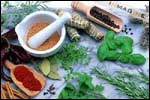 Above we have described the difference between the cherry-laurel (Prunus Laurus cerasus) and the classic laurel (Laurus nobilis), the former only being used for culinary purposes. The latter beautiful evergreen was consecrated by the ancients to priests and heroes, and used in their sacrifices. "A crown of bay" was the earnestly-desired reward for great enterprises, and for the display of uncommon genius in oratory or writing. It was more particularly sacred to Apollo, because, according to the fable, the nymph Daphne was changed into a laurel-tree. The ancients believed, too, that the laurel had the power of communicating the gift of prophecy, as well as poetic genius; and, when they wished to procure pleasant dreams, would place a sprig under the pillow of their bed. It was the symbol, too, of victory, and it was thought that the laurel could never be struck by lightning. From this word comes that of "laureate;" Alfred Tennyson being the present poet laureate, crowned with laurel as the first of living bards. Description: Perennial. Small tree in warm climate. Pot plant in northern climate. An evergreen with large, stiff, dull-green, oblong leaves and yellowish flowers in early spring. Purple, cherry-like berries. Culture: Place plant outdoors in fairly rich sandy loam with good drainage. For a house plant, plant seeds or cuttings in a pot and use rich soil with plenty of humus. The plant needs a cool room in winter. If troubled with scale, wash with baking soda in winter. Plant will put out new leaves in late summer. Preservation: Lay leaves in dark place to dry thoroughly. Uses:
|

Search |
| Comments (0) | Don't be shy, tell us what you think! → |
Colonial Sense is an advocate for global consumer privacy rights, protection and security.
All material on this website © copyright 2009-24 by Colonial Sense, except where otherwise indicated.
ref:T5-S39-P936-C-M
All material on this website © copyright 2009-24 by Colonial Sense, except where otherwise indicated.
ref:T5-S39-P936-C-M

 Basil
Basil


